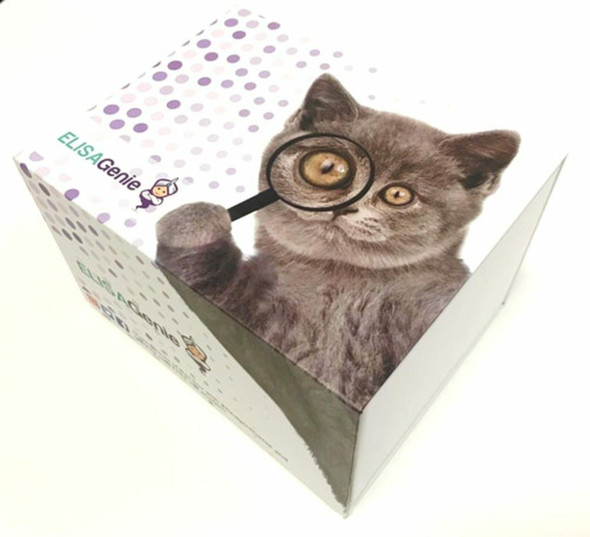Description
| Product Name: | HSPG2 Rabbit pAb |
| Product Code: | CAB20206 |
| Size: | 50uL, 100uL |
| Synonyms: | HSPG, PLC, PRCAN, SJA, SJS, SJS1 |
| Applications: | WB |
| Reactivity: | Human |
| Host Species: | Rabbit |
| Immunogen: | Recombinant fusion protein containing a sequence corresponding to amino acids 22-195 of human HSPG2 (NP_005520.4). |
| Applications: | WB |
| Recommended Dilutions: | WB 1:1000 - 1:2000 |
| Reactivity: | Human |
| Immunogen: | Recombinant fusion protein containing a sequence corresponding to amino acids 22-195 of human HSPG2 (NP_005520.4). |
| Purification Method: | Affinity purification |
| Storage: | Store at -20°C. Avoid freeze / thaw cycles. Buffer: PBS with 0.02% sodium azide, 50% glycerol, pH7.3. |
| Isotype: | IgG |
| Sequence: | Email for sequence |
| Gene ID: | 3339 |
| Uniprot: | P98160 |
| Observed MW: | Refer to figures |
| UniProt Protein Function: | HSPG2: Integral component of basement membranes. Component of the glomerular basement membrane (GBM), responsible for the fixed negative electrostatic membrane charge, and which provides a barrier which is both size- and charge-selective. It serves as an attachment substrate for cells. Plays essential roles in vascularization. Critical for normal heart development and for regulating the vascular response to injury. Also required for avascular cartilage development. Defects in HSPG2 are the cause of Schwartz-Jampel syndrome (SJS1); a rare autosomal recessive disorder characterized by permanent myotonia (prolonged failure of muscle relaxation) and skeletal dysplasia, resulting in reduced stature, kyphoscoliosis, bowing of the diaphyses and irregular epiphyses. Defects in HSPG2 are the cause of dyssegmental dysplasia Silverman-Handmaker type (DDSH). The dyssegmental dysplasias are rare, autosomal recessive skeletal dysplasias with anisospondyly and micromelia. There are two recognized types: the severe, lethal DDSH and the milder Rolland-Desbuquois form. Individuals with DDSH also have a flat face, micrognathia, cleft palate and reduced joint mobility, and frequently have an encephalocoele. The endochondral growth plate is short, the calcospherites (which are spherical calcium-phosphorus crystals produced by hypertrophic chondrocytes) are unfused, and there is mucoid degeneration of the resting cartilage. |
| UniProt Protein Details: | Protein type:Secreted, signal peptide; Motility/polarity/chemotaxis; Secreted; Cell adhesion Chromosomal Location of Human Ortholog: 1p36.1-p34 Cellular Component: extracellular matrix; lysosomal lumen; extracellular space; focal adhesion; Golgi lumen; plasma membrane; extracellular region; basal lamina Molecular Function:protein C-terminus binding; protein binding; metal ion binding Biological Process: cardiac muscle development; phototransduction, visible light; extracellular matrix organization and biogenesis; glycosaminoglycan metabolic process; lipoprotein metabolic process; pathogenesis; embryonic skeletal morphogenesis; chondroitin sulfate metabolic process; extracellular matrix disassembly; glycosaminoglycan biosynthetic process; protein localization; glycosaminoglycan catabolic process; carbohydrate metabolic process; chondrocyte differentiation; angiogenesis; brain development; retinoid metabolic process; endochondral ossification Disease: Schwartz-jampel Syndrome, Type 1; Dyssegmental Dysplasia, Silverman-handmaker Type |
| NCBI Summary: | This gene encodes the perlecan protein, which consists of a core protein to which three long chains of glycosaminoglycans (heparan sulfate or chondroitin sulfate) are attached. The perlecan protein is a large multidomain proteoglycan that binds to and cross-links many extracellular matrix components and cell-surface molecules. It has been shown that this protein interacts with laminin, prolargin, collagen type IV, FGFBP1, FBLN2, FGF7 and transthyretin, etc., and it plays essential roles in multiple biological activities. Perlecan is a key component of the vascular extracellular matrix, where it helps to maintain the endothelial barrier function. It is a potent inhibitor of smooth muscle cell proliferation and is thus thought to help maintain vascular homeostasis. It can also promote growth factor (e.g., FGF2) activity and thus stimulate endothelial growth and re-generation. It is a major component of basement membranes, where it is involved in the stabilization of other molecules as well as being involved with glomerular permeability to macromolecules and cell adhesion. Mutations in this gene cause Schwartz-Jampel syndrome type 1, Silverman-Handmaker type of dyssegmental dysplasia, and tardive dyskinesia. Alternative splicing of this gene results in multiple transcript variants. [provided by RefSeq, May 2014] |
| UniProt Code: | P98160 |
| NCBI GenInfo Identifier: | 13242858 |
| NCBI Gene ID: | 3339 |
| NCBI Accession: | AAB21121.2 |
| UniProt Secondary Accession: | P98160,Q16287, Q5SZI3, Q9H3V5, |
| UniProt Related Accession: | P98160 |
| Molecular Weight: | 468,830 Da |
| NCBI Full Name: | heparan sulfate proteoglycan core protein, partial |
| NCBI Synonym Full Names: | heparan sulfate proteoglycan 2 |
| NCBI Official Symbol: | HSPG2 |
| NCBI Official Synonym Symbols: | PLC; SJA; SJS; HSPG; SJS1; PRCAN |
| NCBI Protein Information: | basement membrane-specific heparan sulfate proteoglycan core protein; perlecan proteoglycan; endorepellin (domain V region) |
| UniProt Protein Name: | Basement membrane-specific heparan sulfate proteoglycan core protein |
| UniProt Synonym Protein Names: | Perlecan; PLC |
| UniProt Gene Name: | HSPG2 |
| UniProt Entry Name: | PGBM_HUMAN |






